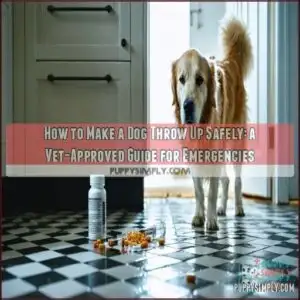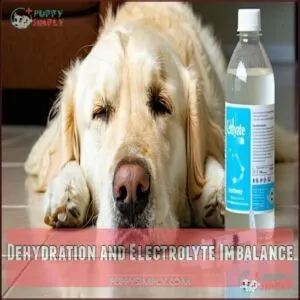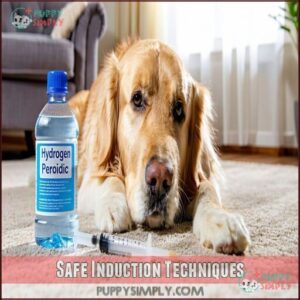This site is supported by our readers. We may earn a commission, at no cost to you, if you purchase through links.
 If your dog eats something dangerous, knowing how to make a dog throw up can be critical—but only with a vet’s approval.
If your dog eats something dangerous, knowing how to make a dog throw up can be critical—but only with a vet’s approval.
First, call your veterinarian or a pet poison control hotline for guidance. If instructed to proceed, hydrogen peroxide (3%) is often recommended.
Use one teaspoon per five pounds of body weight, with a maximum of three tablespoons. Gently administer it with a syringe or turkey baster.
Don’t induce vomiting if your dog swallowed sharp objects, batteries, or caustic substances; it could do more harm than good. Always monitor your dog closely and follow up with your vet immediately.
Table Of Contents
- Key Takeaways
- Making Dog Vomit Safely
- How to Make Dog Throw Up
- When to Induce Vomiting
- Inducing Vomiting Methods
- Risks and Complications
- Post-Induction Care
- Emergency Situations
- Preventing Unnecessary Vomiting
- Veterinary Follow-Up
- Safe Induction Techniques
- Frequently Asked Questions (FAQs)
- Can you make a dog throw up at home?
- How to induce vomiting in a dog at home?
- What does it mean if a dog throws up?
- Can a dog throw up if he eats toxins?
- What can make a dog puke?
- What is the best way to help a dog throw up?
- What does a vet use to induce vomiting?
- What liquid will make a dog throw up?
- Should I be concerned if my dog threw up out of nowhere?
- What should I do if I’m not sure what my dog ate was dangerous?
- Conclusion
Key Takeaways
- Call your vet first to confirm that making your dog vomit is safe and necessary. Never skip this important step.
- Use 3% hydrogen peroxide if your vet approves, at a dosage of 1 teaspoon per 5 pounds of body weight, and administer it carefully with a syringe.
- Don’t induce vomiting for sharp objects, batteries, or caustic substances—this can worsen the situation and cause serious harm.
- Always monitor your dog closely after vomiting and follow up with your vet to ensure there are no complications.
Making Dog Vomit Safely
Making your dog throw up can save their life in emergencies, but it’s not without risks.
Making your dog vomit can be lifesaving, but always consult a vet for safe, effective guidance in emergencies.
Always check with your vet first to confirm it’s the safest choice for your pet.
Importance of Veterinary Guidance
Veterinary guidance is your safety net when deciding to make your dog throw up.
A vet guarantees dosage accuracy, recommends professional emetics, and evaluates if inducing vomiting is safe. Follow their advice for emergencies.
Key steps:
- Call an emergency vet for immediate help.
- Share ingestion details—substance, time, weight.
- Avoid at-home solutions without approval; it’s risky.
Risks of Incorrect Induction
Doing it wrong can hurt your dog.
Incorrect dosage of hydrogen peroxide can cause esophageal damage or even gastric rupture. Aspiration dangers arise if vomit enters the lungs, leading to dog breathing difficulties or pneumonia.
Vomiting might worsen symptoms, like dehydration or electrolyte imbalance.
Always know when to induce vomiting and watch for dog poison symptoms before acting, as this can help prevent further complications such as dehydration.
Precautions for Brachycephalic Breeds
Brachycephalic breeds like pugs and bulldogs, with their flat faces, are more prone to aspiration risks and breathing difficulties.
Inducing vomiting in these dogs can lead to serious complications like aspiration pneumonia.
- Consult your vet before attempting to use hydrogen peroxide.
- Explore safer alternatives recommended by professionals.
- Watch for breed sensitivity—vomiting complications are more common in these dogs, requiring extra care.
How to Make Dog Throw Up
Before trying to make your dog throw up, remember safety comes first. If your vet approves, you can use hydrogen peroxide as an emetic. Stick to Dosage Precision: offer 1 teaspoon per 5-10 pounds, capping at 3 tablespoons for bigger dogs.
Use a syringe or turkey baster to administer it into the side of the dog’s mouth. Keep an eye on Breed Sensitivity, as flat-faced breeds might face added risks. Consider if your dog is also experiencing acid reflux, as this can influence the approach.
It’s important to act carefully:
- Emetic Safety: Only use 3% hydrogen peroxide.
- Timing Matters: Aim for within 1-2 hours of ingestion.
- Alternative Emetics: Don’t improvise without guidance.
- Post-Vomit Care: Watch for unusual symptoms like weakness.
If vomiting doesn’t happen, let your vet induce vomiting instead. Always prioritize their safety!
When to Induce Vomiting
You should only induce vomiting in your dog if they’ve ingested something toxic or harmful, and it’s been less than two hours.
Always check with a veterinarian first to confirm it’s the safest option for your pet.
Ingestion of Toxic Substances
If your dog ingests something toxic—like chocolate, grapes, or medication—act quickly.
Act fast if your dog eats toxins like chocolate or grapes—quick action saves lives!
Call a vet to confirm if inducing vomiting is safe. Dosage matters! Use hydrogen peroxide (3%, 1 teaspoon per 10 pounds).
Not sure? Check this guide:
| Toxic Substance | Safe to Induce? | Dosage Consideration | Risks |
|---|---|---|---|
| Chocolate | Yes, within 2 hours | Weight-based (teaspoon) | Aspiration risk |
| Grapes/Raisins | Yes, immediately | Follow weight guidelines | Kidney toxicity |
| Sharp Objects | No | N/A | Internal damage |
| Medications | Vet approval needed | Double-check dosage | Severe complications possible |
Time matters. Prevention is key—store hazards safely!
Foreign Object Ingestion
If your dog swallows an object, consider its size, material type, and location.
Some items might need surgical options, especially if there’s risk of obstruction.
Before using safe dog emetics like hydrogen peroxide, call a vet.
Don’t induce vomiting for sharp objects or batteries.
Follow these tips:
- Assess object size.
- Note the material type.
- Check obstruction risks.
- Consider breed predisposition.
- Contact a vet immediately.
The key to handling such situations is to act quickly and follow these tips to ensure your dog’s safety.
Gastrointestinal Distress
Gastrointestinal distress often stems from dietary indiscretion, like gobbling spoiled food or trash.
If bloating symptoms appear or your dog’s gut microbiome seems off, call the vet.
Probiotics benefit digestion but won’t fix emergencies.
Sometimes a vet might instruct you to induce vomiting with hydrogen peroxide, and it’s crucial to use caution, since dog vomiting can worsen issues if done unsafely.
Time-Sensitive Situations
Time matters when your dog swallows something harmful. Quick action within two hours can save their life, especially with toxins like antifreeze or chocolate.
- Antifreeze ingestion demands immediate attention; it’s highly toxic.
- Chocolate toxicity and grape ingestion can lead to lethal risks without swift vomiting.
- Rat poison and aspirin overdose require you to act fast before they absorb.
Always prioritize emergency vet care.
Inducing Vomiting Methods
When your dog ingests something harmful, knowing safe methods to induce vomiting can make a critical difference. Always follow proper guidelines to avoid causing more harm than good.
Using Hydrogen Peroxide
Using hydrogen peroxide to induce vomiting in dogs can be helpful but requires caution.
Stick to a 3% solution strength, as higher concentrations are harmful.
Administer 1 teaspoon per 10 pounds of body weight orally, using a syringe or dropper. Redose once if no vomiting occurs in 15 minutes.
Always consult a vet first to avoid potential harm, especially if your dog shows signs of needing a prescription digestive diet, and follow their advice for the best treatment and to ensure the dog’s safety.
Measuring Correct Dosage
Getting the right hydrogen peroxide dosage for dogs requires careful attention.
Use 3% peroxide and calculate based on weight: 1 teaspoon per 5 pounds, max 3 tablespoons.
Consider purchasing helpful tools for precise measurements.
Remember these tips:
- Stick to 3% peroxide concentration.
- Use a syringe for accuracy.
- Never exceed the maximum dosage.
- Timing is key for safe redosing frequency.
- Call your vet to confirm your calculations.
Administering The Solution
When you’re administering the solution, use an oral syringe for precision.
Carefully measure the hydrogen peroxide dog dosage based on weight (1 teaspoon per 5-10 pounds).
Hold your dog’s head gently, squirt the solution into the cheek pouch, and let them swallow.
Monitor for vomiting after 10-15 minutes. If needed, redosing frequency is every 10 minutes, up to three times, to ensure the dog’s safety and the effectiveness of the treatment.
Risks and Complications
Making your dog throw up isn’t without risks, and it’s important to understand the potential complications.
Vomiting can lead to issues like aspiration pneumonia, esophageal damage, or dehydration if not done correctly.
Aspiration Pneumonia
Aspiration pneumonia happens when your dog accidentally inhales vomit into their lungs.
It causes inflammation, breathing difficulty, and serious complications if untreated.
Brachycephalic breeds, like Pugs, are especially at risk.
Symptoms include coughing, wheezing, and lethargy.
Prevent this by seeking veterinary advice before inducing vomiting.
Treatment often requires antibiotics or hospitalization, but with prompt care, the prognosis for dog aspiration is better.
Esophageal Damage
Esophageal damage is a serious concern when you induce vomiting in your dog.
Sharp objects or corrosive substances can lead to ulcer development, stricture formation, or even perforation—a risk no one wants to face. Acid reflux from forced vomiting irritates tissues, increasing the chance of Barrett’s Esophagus or esophagus enlargement.
Always consult a vet to avoid unnecessary dog vomiting risks. It’s also important to rule out conditions like dog tracheal collapse before inducing vomiting.
Dehydration and Electrolyte Imbalance
Induced vomiting can leave your dog dehydrated, causing electrolyte imbalances that affect heart and nerve function.
Watch for dog health concerns, like lethargy or dry gums, and offer fluid replacement or electrolyte solutions if approved by a vet.
Monitoring symptoms closely is key, and veterinary intervention may be needed to prevent complications.
Take preventative measures to minimize dog vomiting complications in emergencies.
Post-Induction Care
After inducing vomiting, it’s vital to closely monitor your dog for any signs of complications like lethargy or trouble breathing.
Keep the vomit for your vet to analyze, as it can help determine the best next steps for treatment.
Monitoring for Complications
After inducing vomiting, keep an eye out for complications. Watch for signs like prolonged vomiting, lethargy, or dehydration. Look for symptoms of aspiration pneumonia, such as coughing or difficulty breathing.
Contact your vet immediately if you suspect gastric ulcers or other dog health risks. Monitoring guarantees safe recovery and proper dog emergency care.
- Symptoms to monitor: breathing changes, lethargy, prolonged vomiting, dehydration signs.
- Immediate action: call a vet if complications arise.
- Common risks: aspiration risk, stomach issues, or worsened conditions.
- Best practice: consult veterinarian guidance to confirm recovery paths align with care.
Collecting Vomit for Analysis
If your dog just threw up, collect the sample quickly for vet analysis. Use a clean container to prevent contamination.
Store it in a sealed bag or jar, refrigerated if needed. This helps during lab testing by preserving the dog’s stomach contents.
Keep it out of reach—dogs may re-eat vomit! Here’s a helpful table:
| Steps | Tips | Why It Matters |
|---|---|---|
| Use a container | Keep it clean | Avoid contamination |
| Seal the sample | Bag or jar | Preserve freshness |
| Refrigerate | Optional | Prevent decomposition |
| Label clearly | Include details | Helps lab testing |
| Watch your dog | Check surroundings | Dogs might re-eat vomit! |
The table provides essential steps and tips for handling your dog’s vomit sample. By following these steps, you can ensure that the sample is properly preserved and useful for lab testing.
Remember to always keep it out of reach of your dog to prevent any further complications.
Providing Soothing Remedies
After collecting the vomit, focus on easing your dog’s nausea. Offer small amounts of water to maintain hydration and soothe their throat.
For a dog upset stomach, try bland food options like boiled chicken and rice in tiny servings. Comfort measures, such as a quiet, cozy spot to rest, can help.
Homeopathic remedies and electrolyte balance aids might provide additional dog nausea relief. Consider using specialized products to help with your dog’s discomfort.
Emergency Situations
When your dog swallows something dangerous, like batteries or caustic substances, acting quickly can save their life. Always consult a veterinarian immediately to guarantee the safest and most effective response.
Ingestion of Caustic Substances
If your dog ingests caustic materials like cleaning agents or corrosive substances, don’t induce vomiting.
It could cause esophageal burns or worsen tissue damage. Instead, focus on neutralization methods such as rinsing their mouth with water, then seek emergency treatment immediately.
Delay increases the risk of toxic substance absorption and long-term effects. Safety here requires swift professional help.
Certain common items represent major dog hazards, making prompt action essential.
Battery Ingestion
If your dog swallows a battery, don’t try to make them vomit.
Batteries, regardless of type, can cause internal damage, from heavy metal toxicity to burns.
Hydrogen peroxide for dogs isn’t safe here.
Instead, contact emergency veterinary care immediately.
These situations often require surgical removal to prevent long-term effects.
Keep all batteries out of reach to protect your pet.
Corrosive Material Ingestion
Corrosive materials, like cleaning products or batteries, can cause esophageal damage and severe internal harm.
Don’t attempt to make your dog throw up; it risks worsening injuries.
Instead, act fast:
- Identify the substance and amount ingested.
- Contact your vet or poison control immediately.
- Avoid neutralization methods without professional advice.
- Monitor for long-term effects or toxic symptoms.
Preventing Unnecessary Vomiting
You can avoid putting your dog through unnecessary vomiting by keeping harmful substances out of reach and closely supervising their environment.
Simple steps like proper storage and knowing when to contact poison control can prevent emergencies before they happen, which is a key aspect of closely supervising their environment.
Storing Hazardous Substances
If you wouldn’t leave candy near a toddler, don’t trust your dog around toxins. Secure cabinets with locks, label containers clearly, and store items like medications, cleaning supplies, and antifreeze out of reach.
Prevent spills and follow proper disposal methods to avoid accidents. Toxic substances need thoughtful care for both child safety and pet safety.
For securing cabinets, consider installing reliable cabinet latches.
| Hazard | Risk | Prevention Tip |
|---|---|---|
| Cleaning Supplies | Poisoning or burns | Use secure cabinets |
| Medications | Toxic ingestion | Label and store high up |
| Antifreeze | Lethal if ingested | Seal lids, avoid spills |
The table highlights specific hazards, including cleaning supplies, medications, and antifreeze, along with their associated risks and prevention tips to ensure a safer environment.
Supervising Dogs Around Hazards
Spotting hazards before mishaps happen can save everyone stress.
Watch for garden dangers like mulch or plants that tempt chewing, especially for breeds prone to mischief.
Keep toxic foods, like chocolate or grapes, out of reach to avoid dog poisoning.
Supervision isn’t just child safety—it’s your pup’s too! Preventing dog toxin ingestion means less need to induce vomiting later.
Educating on Pet Poison Control
Keep harmful substances out of your dog’s reach by prioritizing safe medication storage and toxic plant awareness.
Learn to recognize poisoning signs and have emergency contact info for your vet or pet poison hotline handy.
Poison prevention tips matter—knowing when dog vomiting induction is needed, or when to avoid it, can save lives.
Always seek professional advice before using hydrogen peroxide.
Veterinary Follow-Up
After inducing vomiting, it’s vital to follow up with your veterinarian to guarantee your dog doesn’t face further complications.
They’ll assess your dog’s condition, perform tests if needed, and guide you on the next steps for recovery.
Consulting a Veterinarian
A veterinary consultation is essential when your dog ingests something harmful. Always rely on dog veterinary expertise for guidance. Reach out to an emergency veterinary clinic or Poison Control immediately.
Many pet owners find it convenient to use online vet services for quick advice.
Here’s how to prepare:
- Provide details about the substance ingested.
- Share your dog’s weight and health history.
- Ask about professional methods or medication options.
- Follow post-vomit care instructions carefully.
Importance of Immediate Care
Act fast when your dog ingests something harmful.
Time sensitivity is key, and a rapid response can save them from severe complications.
Professional guidance guarantees your actions are safe and effective, whether using hydrogen peroxide or seeking an emergency vet.
Immediate care improves long-term health, so treat dog vomiting as serious first aid, not guesswork, and remember time sensitivity is crucial.
Follow-Up Examinations and Tests
Your vet might suggest a dog follow-up for vomit analysis, blood tests, or imaging options if complications arise.
These checks guarantee no hidden issues, like internal damage or infection. Hydration status and medication reviews are key to recovery.
A thorough dog vet analysis helps catch adverse reactions early.
Trust your veterinary office—they’ll guide you toward the safest care.
Safe Induction Techniques
In regards to making your dog throw up, it’s important to use methods that are both safe and effective.
Following proven techniques guarantees you minimize risks while helping your pet in an emergency, which is a safe approach.
Using Baking Soda
Using baking soda to make your dog vomit isn’t safe or effective.
It’s an ineffective emetic that can cause serious health problems, including electrolyte imbalances.
Dosage concerns make it risky since even small amounts can harm your dog.
Instead, focus on safe alternatives like hydrogen peroxide under veterinary guidance.
Trust professional dog vomiting methods for reliable, safer results when inducing vomiting.
Using Mustard
Mustard is occasionally mentioned as a natural emetic for dogs, but it’s not the safest option.
Mustard effectiveness varies, and improper mustard dosage can cause palatability issues or harm your dog.
Stick with veterinarian-approved dog vomiting methods like hydrogen peroxide. Using mustard carries risks, so consult your vet first for safer alternatives.
Avoid guessing when your pup’s health is on the line, as this can lead to serious consequences, and instead opt for proper medical advice.
Using Salt
Salt might seem like an easy way to induce vomiting in your dog, but it’s a dangerous choice.
Salt toxicity can cause seizures, dehydration, or even death.
The risks far outweigh any potential benefits. Never use salt or salt water as an emetic.
Stick to safer methods like hydrogen peroxide, and always call your vet first.
Alternative Methods
If you’re considering alternative methods like baking soda, mustard use, or salt solution to dog induce vomiting, think twice.
Such approaches can harm your pet’s stomach or cause serious side effects.
Natural dog emetics like herbal remedies or homeopathic options seem safe but lack reliability.
Always consult a vet first—using improper techniques might create more problems than solutions, which is why it’s crucial to prioritize your pet’s health and seek professional advice to avoid serious side effects.
Frequently Asked Questions (FAQs)
Can you make a dog throw up at home?
Yes, you can, but only with a vet’s guidance.
Use 3% hydrogen peroxide if advised, giving 1 teaspoon per 10 pounds of weight.
Always check with your vet before attempting to guarantee safety.
How to induce vomiting in a dog at home?
To safely induce vomiting in your dog, use 3% hydrogen peroxide: 1 teaspoon per 5 pounds of body weight, up to 3 tablespoons. Always consult your vet first to confirm it’s the right action.
What does it mean if a dog throws up?
If your dog throws up, it could mean anything from mild indigestion to a more serious issue like toxins, illness, or blockages.
Always watch for repeated vomiting and consult your vet if you’re unsure.
Can a dog throw up if he eats toxins?
Like a sudden alarm bell, toxins can irritate your dog’s system, causing vomiting as an instinctive reaction to expel harmful substances.
However, this doesn’t always happen, so quick veterinary advice is absolutely critical.
What can make a dog puke?
Certain items, like 3% hydrogen peroxide, can induce vomiting in dogs when used correctly.
However, always consult a veterinarian first to confirm it’s safe, as some substances or situations make vomiting harmful or even dangerous.
What is the best way to help a dog throw up?
An ounce of prevention is worth a pound of cure.
Contact your vet first.
Use 3% hydrogen peroxide—1 teaspoon per 5 pounds. Administer with a syringe.
If vomiting doesn’t start, seek immediate veterinary help.
What does a vet use to induce vomiting?
Vets often use apomorphine, a medication that triggers vomiting quickly.
It’s administered as an injection or eye drop, ensuring controlled results.
Unlike at-home methods, this approach is safer and more effective under professional supervision.
What liquid will make a dog throw up?
Hydrogen peroxide (3% solution) works to make a dog throw up.
You administer 1 teaspoon per 5 pounds of body weight, up to 3 tablespoons.
Always ask a veterinarian first to confirm it’s safe.
Should I be concerned if my dog threw up out of nowhere?
If your dog vomits suddenly, it could be minor, like stomach upset, or a sign of something serious.
Watch for ongoing symptoms like lethargy or diarrhea, and contact your vet if you’re unsure or concerned.
What should I do if I’m not sure what my dog ate was dangerous?
When in doubt, reach out!
Call your vet or a poison control hotline immediately.
Describe what happened, when it occurred, and your dog’s behavior.
They’ll guide you on whether action is needed.
Conclusion
Helping your dog throw up safely is like traversing a tricky path—you need clear guidance to avoid harm.
Always call a vet first before attempting this at home. If approved, use hydrogen peroxide correctly, stick to safe dosages, and monitor closely.
Avoid inducing vomiting for sharp, caustic, or toxic items, as it might worsen the situation.
Knowing how to make a dog throw up is valuable, but your vet remains the ultimate safety net for your dog’s health.




















